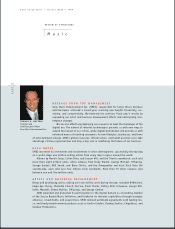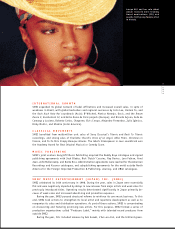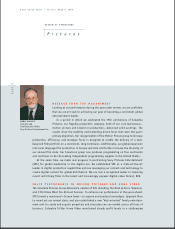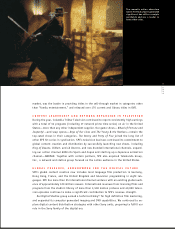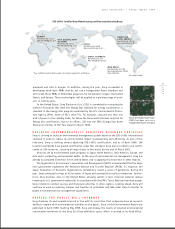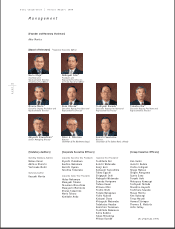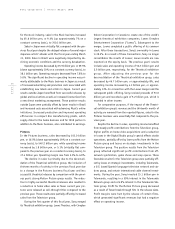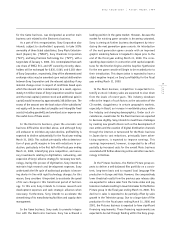Sony 1999 Annual Report Download - page 32
Download and view the complete annual report
Please find page 32 of the 1999 Sony annual report below. You can navigate through the pages in the report by either clicking on the pages listed below, or by using the keyword search tool below to find specific information within the annual report.
Sony Corporation Annual Report 1999
30
page
Current assets decreased by 198.1 billion yen, or 6.1%,
to 3,069.4 billion yen at March 31, 1999. Among current
assets, liquid assets, comprising cash and cash equivalents,
time deposits, and marketable securities increased. Cash and
cash equivalents increased and marketable securities de-
creased because Sony Corporation shifted its short-term in-
vestments from marketable securities to cash equivalents.
Notes and accounts receivable, trade decreased by 95.2 bil-
lion yen, or 7.7%, to 1,135.6 billion yen at March 31, 1999
principally due to the appreciation of the yen. Inventories
decreased by 116.0 billion yen, or 11.7%, to 877.9 billion
yen at March 31, 1999. Sony aggressively reduced produc-
tion volume in the second half of the fiscal year and further
promoted supply chain management. In addition, apprecia-
tion of the yen also impacted the decrease in inventories.
However, the inventory turnover ratio to cost of sales (based
on the average of inventories at March 31, 1998 and 1999)
remained 2.42 months, which was the same level of the
previous fiscal year.
Investments and advances increased by 130.3 billion
yen, or 15.3%, to 980.7 billion yen at March 31, 1999. This
was principally due to an increase in investment assets in
the Insurance business and the deconsolidation of the
Pictures business’ Theatrical exhibition group, Loews Theatres,
due to the merger of Loews Theatres with Cineplex Odeon
Corporation creating Loews Cineplex Entertainment Corpo-
ration (“Loews”) during the fiscal year ended March 31, 1999.
As a result of the merger, Loews is now reported on the
equity basis. (Investment in Loews at March 31, 1999 was
30.7 billion yen.) In addition, Sony invested 27.4 billion
yen in General Instrument Corp. (“GI”), 15.1 billion yen in
Telemundo group (“Telemundo”), and 11.0 billion yen in
S.T. Liquid Crystal Display Corp. (“ST-LCD”). This increase
was partially offset by the contribution of marketable equity
securities held by Sony Corporation to an employee retire-
ment benefit trust (refer to Note 9 of Notes to Consolidated
Financial Statements).
Tangible fixed assets decreased by 97.4 billion yen, or
7.2%, to 1,249.8 billion yen at March 31, 1999, due princi-
pally to the impact of the deconsolidation of Loews Theatres
in connection with the aforementioned merger of the
Theatrical exhibition group.
Total current and long-term liabilities decreased by 122.4
billion yen, or 2.7%, to 4,339.3 billion yen at March 31,
1999. (It is estimated that total liabilities would have
increased by approximately 0.1% compared with the previ-
ous fiscal year-end if the value of the yen had remained the
same as at the previous fiscal year-end.) Among current
liabilities, short-term borrowings and debt declined sharply,
principally due to the redemption of debt by subsidiaries in
Japan and the U.S. Notes and accounts payable, trade de-
clined due principally to the effect of reductions in produc-
tion. Accrued income and other taxes decreased principally
in line with Sony Corporation’s decline in profit. Among
long-term liabilities, the large decline in long-term debt
was principally attributable to redemption of debt by sub-
sidiaries in Japan and the U.S. and the conversion of con-
vertible bonds of Sony Corporation. As a result, the total of
short-term borrowings, current portion of long-term debt,
and long-term debt declined by 137.7 billion yen, or 10.6%,
to 1,166.2 billion yen at March 31, 1999. Accrued pension
and severance costs decreased due to the aforementioned
contribution of marketable securities to an employee re-
tirement benefit trust. Future insurance policy benefits and
other increased in line with net increases in life insurance-
in-force.
Stockholders’ equity increased by 8.1 billion yen, or 0.4%,
to 1,823.7 billion yen at March 31, 1999, mostly reflecting
earnings. The ratio of stockholders’ equity to total assets
increased from 28.4% to 29.0%. Based on the number of
shares outstanding at March 31, 1999, stockholders’ equity
per share declined to 4,448.69 yen from 4,461.39 yen at
the previous fiscal year-end. Foreign currency translation
adjustments at March 31, 1999 increased in amount as a
reduction of stockholders’ equity to 284.4 billion yen from
140.7 billion yen at the previous fiscal year-end, principally
due to the yen’s appreciation.
Cash Flows
Cash and cash equivalents increased by 168.9 billion yen,
or 39.9%, to 592.2 billion yen during the fiscal year ended
March 31, 1999, which includes the negative effect of ex-
change rate changes on cash and cash equivalents of 14.9
billion yen.
Net cash provided by operating activities during the fiscal
year ended March 31, 1999 increased by 50.9 billion yen, or
8.3%, to 663.3 billion yen from the previous fiscal year.
This increase was principally due to a decrease in invento-
ries in the Electronics business and a decrease in notes and
accounts receivable. This increase in net cash provided by


